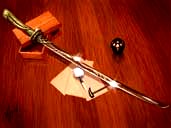Un MJ de Warhammer que je ne citerai pas
Piqué au vif, j'ai donc regardé la gamme l'anneau unique assez développée en VF, mais le carcan chronologique de ce jeu ( de Bilbo à la destruction de l'anneau) me gène.
Je me suis donc rappelé qu'un joueur américain grand spécialiste de D&D basic et AD&D avait écrit un recueil de règles efficaces et simples pour jouer dans les terres du milieu.
Ça s'appelle " Balrogs and bagginses"
Beaucoup de scénarios (Aime, the one ring, JRTM) sont en libre accès sur le net, et ce système (B&B) permet d'adapter tous ces scénarios facilement.
Je dispose égalementd'Atlas et autres cartes des terres du milieu.
Dans un très proche avenir je proposerai donc un one shot (déjà prêt) pour tester et ensuite des parties régulières pour lesquelles nous ferons des personnages définitifs.
L'époque choisie sera bien antérieure à Bilbo le hobbit, soit durant angmar ou juste après sa chute.
En espérant que les fans de Tolkien seront présents.
Je vous copie la 1ere page du jeu (c'est en anglais) qui explique l'âme du jeu, très proche de D&D 5 et Aime d'ailleurs.
Ces règles permettent de jouer un peu comme dans le mmo Lord of the ring online mais façon jeu de rôle.
A bientôt j'espère.
ABOUT THE GAME
Balrogs and Bagginsess (‘B&B’) is a set of rules for table-top roleplaying in the world of Tolkein’s Middle Earth.
The game is based closely on the mechanics and statistics of the Original, Basic and Advanced Dungeons and
Dragons family of games (O, B and AD&D). These games are widely available, understood and loved, and the
author believes they present an excellent (if often unappreciated) format for adventure roleplaying in Middle
Earth. B&B can be thought of as a short set of conversion notes for Middle Earth campaigns using the spells,
monsters, magic items and other materials available through previous Dungeons and Dragons games.
Nevertheless, B&B differs in several important respects from published editions of D&D: most noticeably, it lacks
rigidly defined character classes, replacing them instead with the more flexible and setting-appropriate notions of
‘roles’, which are more flexible concepts that combine character race, homeland and occupation. Also, characters
do not have alignments; instead ‘traits’ provide the mechanism for describing a character’s loves, hates and other
passions. The list of spells available in the game and sorts of characters capable of learning them differ from
official editions of D&D. There are a number of smaller and greater changes in the rules governing attack,
defense, spell casting, saving throws, healing and other detailed mechanical issues. Noteworthy influences include
Pendragon, Prince Valiant, The Fantasy Trip, Tunnels and Trolls, and 3rd and 4th (and even 5th) edition D&D.
Nevertheless, most of these changes are transparent during play: the actual flow of action and most of the rolls
made during a game closely resemble early editions of D&D.
Two things about these rules may be controversial (at least, among those interested to read them!): Many gamers
believe magic in Middle Earth should be subtle and mostly out of the hands of player characters. I believe the
action and spirit of the books are actually captured quite well by the magic of D&D, provided one judiciously
prunes the spell lists to remove powers that are clearly out of step with the setting and re-organizes into groups of
powers that resemble iconic character types in the stories. A more technical argument might be made with my
choice to make B&B compatible with Basic and Advanced D&D rather than one of the more tightly engineered
modern editions. This comes down to a question of taste: the author is old, mentally frayed and prone to nostalgia,
and so pre-3rd edition forms of the game are a natural personal choice. These editions also have a more whimsical
tone and flexible approach to rules. I believe both of these characteristics can help gaming groups explore their
understanding of Tolkien’s worlds through free-form roleplaying rather than a rigid set of mechanics. Note that in
making this choice I’ve forced on the readers the long-debated descending scale for armor class used in pre-3rd
editions of D&D. If this is simply too difficult or aesthetically distasteful for you to accept, I’m giving you one last
chance to set down this book or close your pdf reader and walk away.
The monsters, spells and magic items for Balrogs and Bagginses are directly from or closely patterned after
previous editions of Basic and Advanced Dungeons and Dragons. This mechanical compatibility with previous
editions means groups can freely import incorporate content from previous editions consistent with their own vision
of the setting. Shambling mounds in the Old Forest? Lurker’s Above in the Underdeeps? A deck of many things in
Saruman’s library? You won’t find these things explicitly included in this volume, but if you wish to include them in
your campaign, knock yourself out!

















